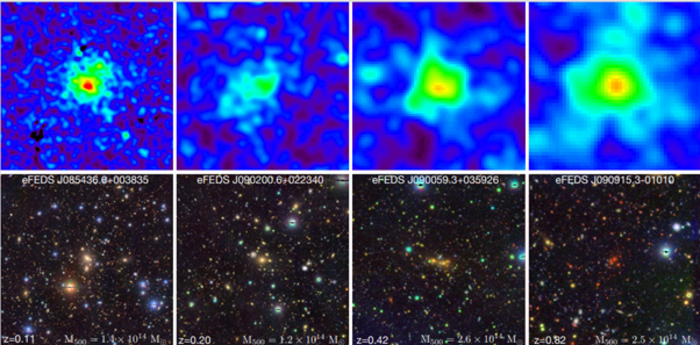In the late 20th century, the observation of a type one-A supernova led to the discovery of accelerating expansion of our Universe. Up until now, however, scientists have not been able to fathom the energy driving this acceleration. Referred to as “Dark Energy,” this mysterious energy behaves like “anti-gravity,” pushing objects away from each other. Fortunately, the effects of this Dark Energy can be analyzed by focusing on the number and distribution of galaxy clusters, which are the largest objects in the known Universe.

Credit: Matthias Klein from Ludwig-Maximilians-Universität, Germany
In the late 20th century, the observation of a type one-A supernova led to the discovery of accelerating expansion of our Universe. Up until now, however, scientists have not been able to fathom the energy driving this acceleration. Referred to as “Dark Energy,” this mysterious energy behaves like “anti-gravity,” pushing objects away from each other. Fortunately, the effects of this Dark Energy can be analyzed by focusing on the number and distribution of galaxy clusters, which are the largest objects in the known Universe.
Galaxy clusters are, however, uncommon and locating them requires scanning a significant portion of the sky with extremely sophisticated telescopes. One such telescope, the eROSITA X-ray space telescope, launched in 2019 by the Max Planck Institute for Extraterrestrial Physics in Germany, is set to carry out the deepest full-sky survey in X-rays. Nonetheless, a dataset from a mini-survey called the eROSITA Final Equatorial Depth Survey (eFEDS), containing a sample of about 550 galaxy clusters, has already been published.
Against this backdrop, a research group led by Professor I-Non Chiu from National Cheng Kung University (NCKU), Taiwan decided to conduct the first cosmological study on the eFEDS data, which also serves as the first cosmological study on galaxy clusters identified by eROSITA. Their paper was published in Volume 522, Issue 2 of Monthly Notices of the Royal Astronomical Society on April 21, 2023.
In this first-ever synergistic study combining data from X-ray and optical surveys, the researchers combined the eFEDS X-ray data with state-of-the-art optical data from the Hyper Suprime-Cam Subaru Strategic Program led by Taiwan, Japan, and Princeton University, USA. To reduce contamination (noise), the team first built a galaxy cluster sample using the X-ray telescope data. They then further cleaned this sample using optical data and estimated the clusters’ masses to perform cosmological calculations.
Comparing their results with theoretical predictions, the researchers found that Dark Energy occupies up to 76% of the total energy density in the Universe. Additionally, the equation of state of Dark Energy described the relationship between its pressure and energy density, as well as the constraints on Dark Energy. Furthermore, these results also agree well with the other independent prediction approaches, such as those using gravitational lensing and Cosmic Microwave Background.
Prof. Chiu explains, “Based on our results, the energy density of Dark Energy appears to be uniform in space and constant in time, resembling a true constant in the Universe, and in good agreement with other independent experiments.” Indeed, observational evidence from the study suggests that Dark Energy can be described by a simple constant, namely the cosmological constant Λ.
Though the current errors on the Dark Energy constraints are still large, the researchers used samples from eFEDS, that occupies an area less than 1% of the full-sky. Highlighting the need for larger datasets, Prof. Chiu says, “Future studies using the full-sky sample will significantly improve our understanding of Dark Energy. Our study has laid a solid foundation for subsequent works towards this goal.” The researchers anticipate that faster computational approaches will be required in the future, given the massive increase in data size a full-sky survey will entail, and are already taking this into consideration.
We certainly hope that the eROSITA survey will help clarify one of the deepest mysteries of the cosmos!
***
Reference
DOI: https://doi.org/10.1093/mnras/stad957
Authors: I-Non Chiu1,2,3, Matthias Klein4, Joseph Mohr4,5, and Sebastian Bocquet4
Affiliations:
1Tsung-Dao Lee Institute, Shanghai Jiao Tong University
2Department of Astronomy, School of Physics and Astronomy, and Shanghai Key Laboratory for Particle Physics and Cosmology, Shanghai Jiao Tong University
3Department of Physics, National Cheng Kung University
4University Observatory, Faculty of Physics, Ludwig-Maximilians-Universität
5Max Planck Institute for Extraterrestrial Physics
About NCKU, Taiwan
Established first in 1931 under the name of Tainan Technical College, National Cheng Kung University (NCKU) is a public university in Tainan, Taiwan. Currently spread over a total area of approximately 186 hectares, including 8 main campuses and 3 satellite campuses, NCKU has come a long way since its inception 90 years ago. With 9 colleges, 44 departments, and 15 university-level research centers, NCKU aims to cultivate critical thinking, empathy, and imagination, and strives to improve the wellbeing of humankind and become a university of excellence in education, research, and social responsibility. “Seek for Truth; Toil for Good” is the university’s motto.
Website: https://www.ncku.edu.tw/
About Assistant Professor I-Non Chiu from National Cheng Kung University
I-Non Chiu is an Assistant Professor in the Department of Physics at National Cheng Kung University (NCKU), Taiwan. Prior to this role, Assistant Prof. Chiu was an independent postdoctoral researcher at the Tsung-Dao Lee Institute and Shanghai Jiao Tong University. Chiu has obtained his PhD from the Ludwig Maximillans University in 2016 and Masters in Astrophysics from the National Taiwan University and ASIAA. Assistant Prof. Chiu research interests lie in the field of observational cosmology and astrophysics with a focus on utilizing galaxy clusters as a probe. He has close to 55 research publications to his credit.
Journal
Monthly Notices of the Royal Astronomical Society
DOI
10.1093/mnras/stad957
Method of Research
Computational simulation/modeling
Subject of Research
Not applicable
Article Title
Cosmological Constraints from Galaxy Clusters and Groups in the eROSITA Final Equatorial Depth Survey
Article Publication Date
21-Apr-2023




